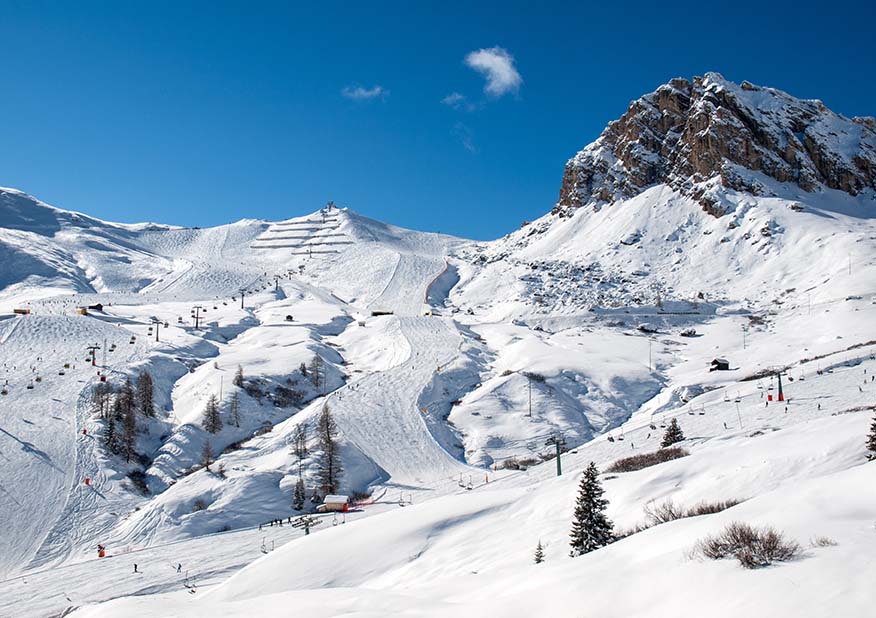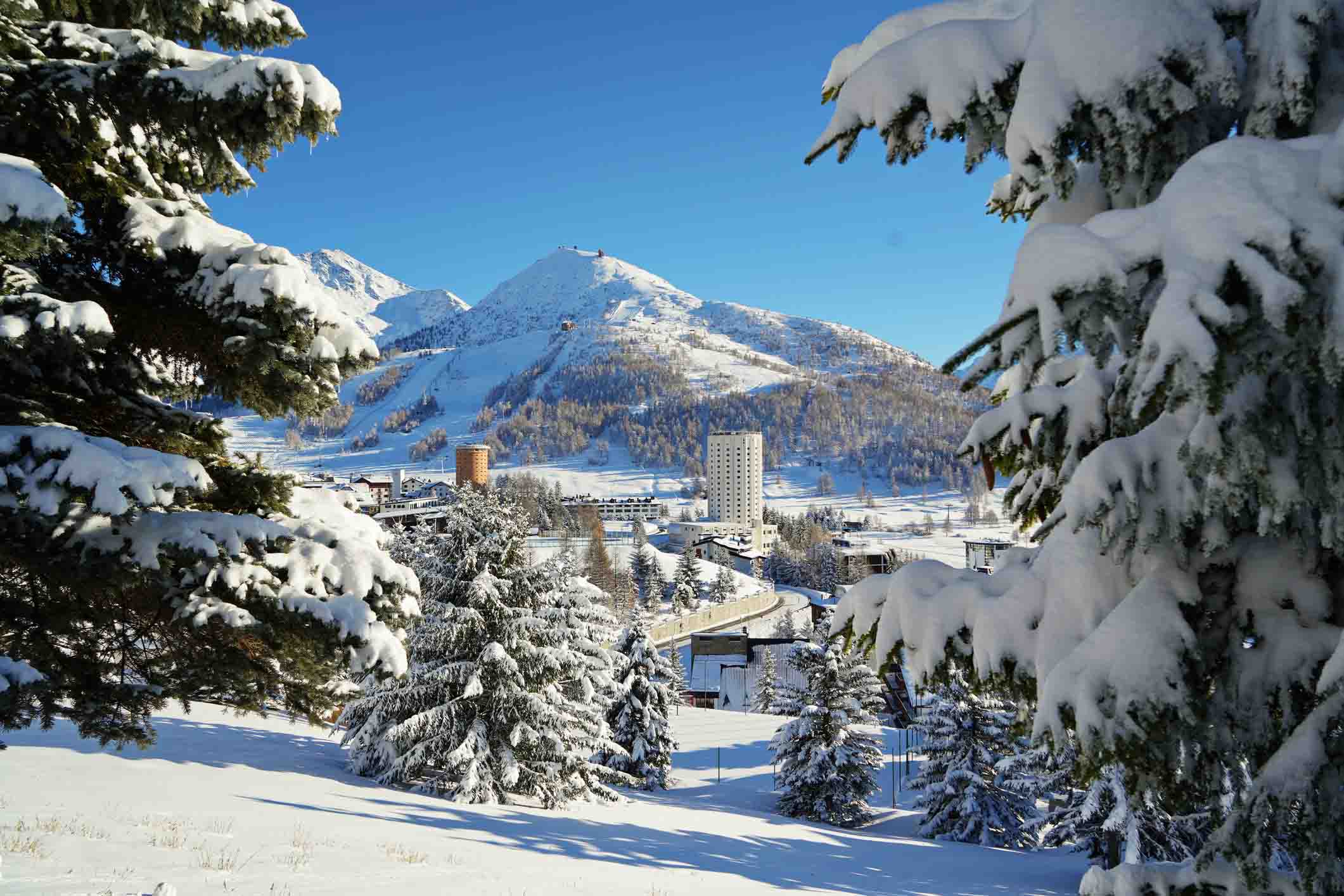Italy, renowned for its rich history, exquisite cuisine, and mesmering landscapes, is also a hidden gem for avid skiers. Nestled in the heart of the Alps, the collection of world-class ski resorts in Italy cater to every type of skier. Embracing the magic of these winter wonderlands rewards you with an unforgettable skiing experience, once you’ve settled on which one to pick.
The reasons Italy is such a popular destination with skiers are largely its blend of diverse terrains, cultural experiences, and affordability. From the chic slopes of Cortina d’Ampezzo to the charming ambience of Courmayeur and the challenging slopes of the Dolomites, each area and resort provides unique skiing set against breathtaking alpine scenery. Whether you’re a beginner or an expert, skiing in Italy promises an unforgettable adventure.
In this guide, we explore some of the best ski resorts in Italy. We’ll outline budget range, terrain, required skill levels, facilities, and each resort’s unique surroundings.
Does Italy have good skiing?
Skiing in Italy is known to be a special experience among winter sports lovers. The country boasts a range of destinations, each with its unique charm and character. Whether you’re a novice or an expert skier, Italy’s ski resorts offer various slopes to cater to all skill levels. The combination of Instagram-worthy scenery, well-groomed pistes, and animated après-ski culture makes it an excellent choice for skiing enthusiasts who also want to make lasting memories on holiday.
Where do you fly to for skiing in Italy?
Choosing the right airport is of course crucial when planning your skiing trip. Italy’s major airports serving its popular ski destinations include:
Turin Airport (Caselle) – Ideal for resorts in the Aosta Valley, including Courmayeur
Milan Malpensa Airport – Convenient for resorts in the Lombardy region, such as Bormio
Innsbruck Airport (Austria) – Suitable for those heading to the Dolomites, including Cortina d’Ampezzo
Venice Marco Polo Airport – A gateway to resorts in the Dolomites and the Trentino region
Once at the airport, you have various transportation options, including buses, trains, and private transfers, which give you easy access to the ski resorts.
What months can you ski in Italy?
The skiing season in Italy typically runs from late November to early May, depending on the specific resort and altitude. Higher-altitude resorts like Cervinia and Courmayeur often extend their seasons, providing skiers with a more extended window to enjoy the slopes. To benefit from optimal snow conditions, planning a ski trip between December and March is advisable. Once you’ve decided where you’ll go, it’s wise to check with your resort on their current operating seasons.
Italy’s best ski resorts
As you plan your skiing trip to Italy, you’ll want to consider factors such as your skiing skill level, preferred atmosphere, and budget, in order to choose the resort that best meets your needs. Assess the resort’s slope difficulty, amenities, and off-piste options. Check snow conditions and the resort’s altitude for reliable snowfall, as well as its accessibility and nearby attractions. Research reviews, get recommendations from other skiers, and compare prices for lift tickets and rentals.
Here’s a guide to some of the best Italian ski resorts.
1. Cortina d’Ampezzo

Location: Belluno, Veneto
Pricing: A one-day adult ski pass costs between 67 and 80 euros
Terrain: Diverse, catering to all skill levels from beginners to advanced skiers, with both groomed pistes and challenging off-piste options.
Facilities: Upscale with a glamorous atmosphere, offering luxury accommodations and excellent evening entertainment.
Surrounding area: Belluno will enchant you with its scenic beauty, encompassing both the Dolomites and an array of pretty villages. Rich in cultural heritage, the town of Belluno itself is the capital of the region and known as the most important city of the eastern Dolomites. It contains historical sites and is steeped in authenticity, with local traditions still to be seen everywhere. Whether you scale staggering peaks, hike pristine trails or indulge in authentic Venetian cuisine, there’s plenty to love here.
2. Courmayeur

Location: Upper Aosta valley
Pricing: A one-day adult ski pass costs between 59 and 77 euros
Terrain: Varied slopes for all levels, with a focus on a mix of gentle runs and challenging terrain.
Facilities: Charming village atmosphere with a culinary focus, offering a combination of traditional and modern amenities.
Surrounding Area: In the Aosta Valley, you can take in breathtaking views of Mont Blanc and access charming medieval towns. Immerse yourself in rich history, explore historic castles and indulge in authentic Aostan cuisine.
3. Alta Badia

Location: Corvara, South Tyrol
Pricing: A one-day adult ski pass costs between 67 and 74 euros
Terrain: Relaxed atmosphere with well-groomed slopes, ideal for intermediate skiers.
Facilities: Emphasis on gourmet dining and cultural experiences, blending traditional Ladin culture with modern amenities.
Surrounding Area: Positioned strategically within the Dolomiti Superski area, the resort is set against a backdrop of awe-inspiring panoramas. Corvara’s welcoming village atmosphere resonates with authentic alpine hospitality, for a perfect retreat after exhilarating days on the slopes. Gourmet dining establishments dot the landscape, with further cultural richness from local architecture, artisanal crafts and good nightlife.
4. Livigno

Location: Alta Valtellina
Pricing: A one-day adult ski pass costs between 33.50 and 46.50 euros
Terrain: Wide range of slopes suitable for all skill levels. A dedicated terrain park adds a touch of thrill for freestyle fanatics.
Facilities: Affordable options with a duty-free status which makes it attractive for shoppers, as well as lively eateries and drinking spots.
Surrounding Area: Near the Swiss border, Livigno provides reliable snow conditions with its a high-altitude location. The crystal-clear lakes are a draw in themselves, with fishing commonly enjoyed there at certain times of the year.
5. Bormio

Location: Lombardy region
Pricing: A one-day adult ski pass costs between 32 and 56 euros
Terrain: Well-suited for intermediate and advanced skiers. Bormio has challenging slopes and a mix of on and off-piste areas, complemented by the world-renowned Stelvio piste.
Facilities: Bormio is famous for its thermal baths, adding a relaxing touch to the après-ski experience. The resort also hosts World Cup events, attesting to its challenging slopes.
Surrounding area: The area’s historical significance is evident in its medieval villages, Renaissance architecture and castles, while the iconic city of Milan can be reached in a few hours if you want a day of urban sightseeing. Lombardy’s rich culinary scene, celebrated for dishes like risotto and polenta, is also a huge draw for foodies.
6. Cervinia

Location: Aosta Valley
Pricing: A one-day adult ski pass costs between 59 and 83 euros
Terrain: Known for its extensive high-altitude skiing and connections to Zermatt in Switzerland, Cervinia offers a mix of slopes suitable for all levels, with stunning panoramic views of the Matterhorn.
Facilities: The resort’s modern facilities and high altitude guarantee excellent snow conditions throughout the season. A vibrant après-ski offering complements the ski experience.
Surrounding area: The region’s gastronomy, with hearty mountain fare and renowned wines, adds a culinary dimension to your trip that provides ample reward for pushing yourself on the slopes.
7. Sestriere

Location: Piedmont region
Pricing: A one-day adult ski pass costs between 40 and 44 euros
Terrain: Part of the vast Milky Way ski area, Sestriere is ideal for intermediate skiers, with well-groomed pistes. Advanced skiers can explore challenging runs and off-piste areas.
Facilities: As a host of the 2006 Winter Olympics, Sestriere has superior facilities, including a variety of accommodation options and a lively après-ski scene.
Surrounding area: Sestriere is only around a half-hour drive from Turin, which gives you the option to visit historic palaces, museums, and experience a burgeoning contemporary arts scene. The Langhe and Roero hills, famed for their vineyards, serve as a haven for wine lovers, being home to the renowned Barolo and Barbaresco varieties.
8. Madonna di Campiglio

Location: Trentino region
Pricing: A one-day adult ski pass costs between 43.20 and 75.10 euros
Terrain: The resort offers a mix of slopes suitable for all levels; it is renowned for its tree-lined runs and stunning scenery.
Facilities: The charming village, upscale accommodations, and a range of dining options contribute to Madonna di Campiglio’s appeal. It’s a favourite among both families and discerning skiers.
Surrounding area: Nestled in the Brenta Dolomites, Trentino is also home to picture-perfect towns like Trento and Rovereto, as well as ultra-scenic spots Lake Garda and Lake Molveno.
9. Alagna Valsesia (Monterosa Ski)

Location: Piedmont region
Pricing: A one-day adult ski pass costs between 38.50 and 65 euros
Terrain: Alagna Valsesia is part of the expansive Monterosa Ski area, known for its challenging off-piste terrain and substantial ski routes. It caters to advanced skiers wanting a backcountry experience.
Facilities: The village retains its traditional alpine charm, and the resort’s focus on off-piste and freeride opportunities makes it a haven for adventurous skiers.
Surrounding area: The natural beauty of the Valsesia valley offers a perfect escape, with its tranquility and riverside relaxation standing in contrast to high-altitude skiing adventures. You can also enjoy activities such as whitewater rafting and hikes packed with stunning nature.
Is Italy or France better for skiing?
Both Italy and France boast world-class ski resorts, each with undeniable appeal and all the elements to make a great skiing holiday. So how to decide on which one to pick? The choice between the two ultimately depends on your personal preferences and priorities, though there are some differing factors that could help to sway your decision.
Terrain and skiing experience
Italy offers a wide range of terrains for everyone from novices to professionals, including the challenging slopes of the Dolomites and the wide pistes of the Aosta Valley.
France is known for its expansive ski areas and high-altitude resorts. The French Alps, with resorts like Chamonix and Val d’Isère, are renowned for their vast networks of slopes and off-piste skiing.
Atmosphere and culture
Italy boasts a relaxed and welcoming atmosphere, with a focus on good food, local traditions, and picturesque villages. Après-ski in Italy often includes enjoying local wines and indulging in gourmet cuisine. The culture emphasises quality over quantity, with cosy mountain huts and traditional taverns creating a warm and inviting atmosphere. You can bask in a more intimate ambience and personalised experience, rather than the sometimes crowded nature of larger resorts in France.
France offers great après-ski culture, with a cosmopolitan atmosphere and a focus on nightlife. French resorts are known for their buzzing social scenes, making them ideal if you’re after a more energetic atmosphere to round off a day on the slopes.
Affordability
Italy is generally more budget-friendly than its French counterparts, with a range of accommodations and dining options to suit various budgets. Italy’s ski resorts often provide reasonably priced ski passes and rental equipment too.
France tends to be more expensive, especially in high-profile resorts. However, the investment often pays for ample ski areas and first-class facilities.
Get skiing insurance with SportsCover Direct
Skiing provides some of the most exciting thrills you can experience in the great outdoors. To give yourself the best chance of enjoying your time on the slopes, it’s crucial to protect yourself against the sport’s risks by taking out skiing insurance. By investing in coverage, you’ll be able to prioritise safety, have peace of mind, and have the assurance of financial protection in unforeseen circumstances.
SportsCover Direct’s skiing insurance provides essential coverage for various expenses, with three different policy options. They include travel insurance for medical costs, trip cancellations and more while skiing abroad, whether for leisure or competition. There’s also a bolt-on option if you have an existing travel insurance policy that doesn’t cover you for skiing. Then there’s our sports accident insurance policy, which is designed for skiing in the UK. This incorporates both accident insurance and income protection.
Find out more and get a quote online.
This blog has been created as general information and should not be taken as advice. Make sure you have the correct level of insurance for your requirements and always review policy documentation.